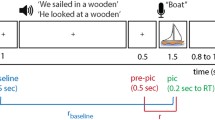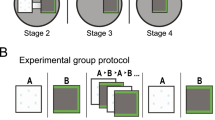One of the most important mechanisms underlying the flexible regulation of behavior is subjects’ ability to compare and integrate information about the world with information constantly coming from outside. We report here studies using stereoelectroencephalography to record the hippocampal local field potential in subjects performing a task of assessing the congruence of “object–context” stimulus pairs. These investigations showed that the hippocampus is involved in processing object-context congruence information. Processing of information congruent to previously formed semantic knowledge is accompanied by earlier hippocampal activation than processing information requiring establishment of new associative links.
Similar content being viewed by others
References
Anderson, R. C., “Role of the reader’s schema in comprehension, learning, and memory,” in: Theoretical Models and Processes of Literacy, Alvermann, D. E. et al. (eds.), Routledge, New York (2018), pp. 136–145.
Axmacher, N., Cohen, M. X., Fell, J., et al., “Intracranial EEG correlates of expectancy and memory formation in the human hippocampus and nucleus accumbens,” Neuron, 65, No. 4, 541–549 (2010).
Axmacher, N., Elger, C. E., and Fell, J., “Working memory-related hippocampal deactivation interferes with long-term memory formation,” J. Neurosci., 29, No. 4, 1052–1060 (2009).
Bartlett, F. C. and Burt, C., “Remembering: a study in experimental and social psychology,” Br. J. Educ. Psychol., 3, No. 2, 187–192 (1933).
Bermúdez-Margaretto, B., Beltrán, D., Cuetos, F., and Domínguez, A., “Brain signatures of new (pseudo-) words: Visual repetition in associative and non-associative contexts,” Front. Hum. Neurosci., 12, 354 (2018).
Buzsáki, G. and Llinás, R., “Space and time in the brain,” Science, 358, No. 6362, 482–485 (2017).
Buzsáki, G. and Tingley, D., “Space and time: The hippocampus as a sequence generator,” Trends Cogn. Sci., 22, No. 10, 853–869 (2018).
Buzsáki, G., Anastassiou, C. A., and Koch, C., “The origin of extracellular fields and currents-EEG, ECoG, LFP and spikes,” Nat. Rev. Neurosci., 13, No. 6, 407–420 (2012).
Cohen, M. X., Elger, C. E., and Ranganath, C., “Reward expectation modulates feedback-related negativity and EEG spectra,” NeuroImage, 35, No. 2, 968–978 (2007).
Davis, C. P., Altmann, G. T. M., and Yee, E., “Situational systematicity: A role for schema in understanding the differences between abstract and concrete concepts,” Cogn. Neuropsychol., 37, No. 1–2, 142–153 (2020).
Eichenbaum, H., “Memory: organization and control,” Annu. Rev. Psychol., 68, No. 1, 19–45 (2017).
Fernández, G. and Morris, R. G. M., “Memory, novelty and prior knowledge,” Trends Neurosci., 41, No. 10, 654–659 (2018).
Frank, D., Montaldi, D., Wittmann, B., and Talmi, D., “Beneficial and detrimental effects of schema incongruence on memory for contextual events,” Learn. Mem., 25, No. 8, 352–360 (2018).
Ghosh, V. E. and Gilboa, A., “What is a memory schema? A historical perspective on current neuroscience literature,” Neuropsychologia, 53, No. 1, 104–114 (2014).
Gilboa, A. and Marlatte, H., “Neurobiology of schemas and schema-mediated memory,” Trends Cogn. Sci., 21, No. 8, 618–631 (2017).
Ivashkina, O. I., Toropova, K. A., Roshchina, M. A., and Anokhin, K. V., “Formation and retrieval of associative memory for complex signals in mice: specifi c involvement of hippocampal field CA1 neurons,” Zh. Vyssh. Nerv. Deyat., 70, No. 3, 326–340 (2020).
Korsakov, S. S., “A medical-biological study of one form of memory impairment,” in: The Psychology of Memory: A Reader, CheRo, Moscow (1998), pp. 62–75.
Köster, M., Finger, H., Graetz, S., et al., “Theta-gamma coupling binds visual perceptual features in an associative memory task,” Sci. Rep., 8, No. 1, 1–9 (2018).
Kutas, M. and Hillyard, S. A., “Reading between the lines: Event-related brain potentials during natural sentence processing,” Brain Lang., 11, No. 2, 354–373 (1980).
Leont’ev, A. N., The Development of Memory: an Experimental Study of the Development of Higher Psychological Functions, Smysl, Moscow (2003), pp. 27–199.
Li, F., Yi, C., Jiang, Y., et al., “Different contexts in the oddball paradigm induce distinct brain networks in generating the P300,” Front. Hum. Neurosci., 12, January, 1–10 (2019).
Lisman, J., Buzsáki, G., Eichenbaum, H., et al., “Viewpoints: How the hippocampus contributes to memory, navigation and cognition,” Nat. Neurosci., 20, No. 11, 1434–1447 (2017).
Luo, W. and Guan, J.-S., “Do brain oscillations orchestrate memory?” Brain Sci. Adv., 4, No. 1, 16–33 (2018).
Miller, J., Watrous, A. J., Tsitsiklis, M., et al., “Lateralized hippocampal oscillations underlie distinct aspects of human spatial memory and navigation,” Nat. Commun., 9, No. 1, 2423 (2018).
Milner, B., Corkin, S., and Teuber, H.-L., “Further analysis of the hippocampal amnesic syndrome: 14-year follow-up study of HM,” Neuropsychologia, 6, No. 3, 215–234 (1968).
Mohan, H., Verhoog, M. B., Doreswamy, K. K., et al., “Dendritic and axonal architecture of individual pyramidal neurons across layers of adult human neocortex,” Cereb. Cortex, 25, No. 12, 4839–4853 (2015).
Molnár, G., Oláh, S., Komlósi, G., et al., “Complex events initiated by individual spikes in the human cerebral cortex,” PLoS Biol., 6, No. 9, 1842–1849 (2008).
Morett, L. M., Landi, N., Irwin, J., and McPartland, J. C., “N400 amplitude, latency, and variability reflect temporal integration of beat gesture and pitch accent during language processing,” Brain Res., 1747, 147059 (2020).
Morris, R. G. M., “Theories of hippocampal function,” in: The Hippocampus Book, Andersen, P. et al. (eds.), Oxford University Press, Oxford, UK (2006), pp. 581–713.
Murray, E. A., Wise, S. P., and Graham, K. S., “Representational specializations of the hippocampus in phylogenetic perspective,” Neurosci. Lett., 680, 4–12 (2018).
Nadel, L., Campbell, J., and Ryan, L., “Autobiographical memory retrieval and hippocampal activation as a function of repetition and the passage of time,” Neural Plast., 2007, 1–14 (2007).
Oostenveld, R., Fries, P., Maris, E., and Schoffelen, J.-M., “FieldTrip: Open source software for advanced analysis of MEG, EEG, and invasive electrophysiological data,” Comput. Intell. Neurosci., 2011, 1–9 (2011).
O’Reilly, R. C. and Rudy, J. W., “Conjunctive representations in learning and memory: Principles of cortical and hippocampal function,” Psychol. Rev., 108, No. 2, 311–345 (2001).
Parvizi, J. and Kastner, S., “Promises and limitations of human intracranial electroencephalography,” Nat. Neurosci., 21, No. 4, 474–483 (2018).
Piaget, J., The Psychology of Intelligence [Russian translation], Piter, St. Petersburg (2003).
Polich, J., “Updating P300: an integrative theory of P3a and P3b,” Clin. Neurophysiol., 118, No. 10, 2128–2148 (2007).
Staresina, B. P., Fell, J., Do Lam, A. T. A., et al., “Memory signals are temporally dissociated in and across human hippocampus and perirhinal cortex,” Nat. Neurosci., 15, No. 8, 1167–1173 (2012).
Staresina, B. P., Fell, J., Dunn, J. C., et al., “Using state-trace analysis to dissociate the functions of the human hippocampus and perirhinal cortex in recognition memory,” Proc. Natl. Acad. Sci. USA, 110, No. 8, 3119–3124 (2013).
Staresina, B. P., Reber, T. P., Niediek, J., et al., “Recollection in the human hippocampal-entorhinal cell circuitry,” Nat. Commun., 10, No. 1, 1503 (2019).
Stark, S. M., Reagh, Z. M., Yassa, M. A., and Stark, C. E. L., “What’s in a context? Cautions, limitations, and potential paths forward,” Neurosci. Lett., 680, 77–87 (2018).
Strange, B. A., Witter, M. P., Lein, E. S., and Moser, E. I., “Functional organization of the hippocampal longitudinal axis,” Nat. Rev. Neurosci., 15, No. 10, 655–669 (2014).
Sutton, S., Braren, M., Zubin, J., and John, E. R., “Evoked-potential correlates of stimulus uncertainty,” Science, 150, No. 3700, 1187–1188 (1965).
Tadel, F., Baillet, S., Mosher, J. C., et al., “Brainstorm: A user-friendly application for MEG/EEG analysis,” Comput. Intell. Neurosci., 2011, 1–13 (2011).
Tonegawa, S., Morrissey, M. D., and Kitamura, T., “The role of engram cells in the systems consolidation of memory,” Nat. Rev. Neurosci., 19, No. 8, 485–498 (2018).
Toropova, K. A., Troshev, D. V., Ivashkina, O. I., and Anokhin, K. V., “Activation of c-fos expression in the retrosplenial cortex but not the hippocampus is accompanied by formation of associations between context and the unconditioned stimulus and its subsequent retrieval in mice,” Zh. Vyssh. Nerv. Deyat., 68, No. 6, 759–774 (2018).
Tulving, E., “Episodic and semantic memory,” in: Organization of Memory, Tulving, E. and Donaldson, W. (eds.), Academic Press, New York (1972), pp. 381–403.
van der Linden, M., Berkers R. M. W. J., Morris, R. G. M., and Fernández, G., “Angular gyrus involvement at encoding and retrieval is associated with durable but less specifi c memories,” J. Neurosci., 37, No. 39, 9474–9485 (2017).
van Kesteren, M. T. R., Beul, S. F., Takashima, A., et al., “Differential roles for medial prefrontal and medial temporal cortices in schema-dependent encoding: From congruent to incongruent,” Neuropsychologia, 51, No. 12, 2352–2359 (2013).
van Kesteren, M. T. R., Ruiter, D. J., Fernández, G., and Henson, R. N., “How schema and novelty augment memory formation,” Trends Neurosci., 35, No. 4, 211–219 (2012).
Van Strien, J. W., Hagenbeek, R. E., Stam, C. J., et al., “Changes in brain electrical activity during extended continuous word recognition,” NeuroImage, 26, No. 3, 952–959 (2005).
Vogel, S., Kluen, L. M., Fernández, G., and Schwabe, L., “Stress leads to aberrant hippocampal involvement when processing schema-related information,” Learn. Mem., 25, No. 1, 21–30 (2018).
Xia, X. and Hu, L., “EEG: Neural basis and measurement,” in: EEG Signal Processing and Feature Extraction, Springer Singapore, Singapore (2019), pp. 7–21.
Yaple, Z., Shestakova, A., and Klucharev, V., “Feedback-related negativity reflects omission of monetary gains: Evidence from ERP gambling study,” Neurosci. Lett., 686, No. July, 145–149 (2018).
Youngerman, B. E., Khan, F. A., and McKhann, G. M., “Stereoelectroencephalography in epilepsy, cognitive neurophysiology, and psychiatric disease: safety, efficacy, and place in therapy,” Neuropsychiatr. Dis. Treat., 15, 1701–1716 (2019).
Author information
Authors and Affiliations
Corresponding author
Additional information
E. F. Pavone is deceased
Translated from Zhurnal Vysshei Nervnoi Deyatel’nosti imeni I. P. Pavlova, Vol. 72, No. 3, pp. 360–369, May–June, 2022.
Rights and permissions
Springer Nature or its licensor (e.g. a society or other partner) holds exclusive rights to this article under a publishing agreement with the author(s) or other rightsholder(s); author self-archiving of the accepted manuscript version of this article is solely governed by the terms of such publishing agreement and applicable law.
About this article
Cite this article
Vorobiova, A.N., Fedele, T., Pavone, E.F. et al. The Speed of Hippocampal Processing of Contextual Information is Linked with Its Congruence with Previously Developed Schemas. Neurosci Behav Physi 52, 1429–1435 (2022). https://doi.org/10.1007/s11055-023-01374-z
Received:
Accepted:
Published:
Issue Date:
DOI: https://doi.org/10.1007/s11055-023-01374-z




